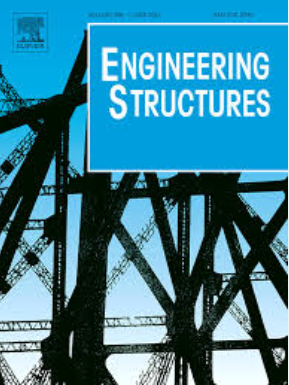定向刨花板与冷弯型钢之间的螺钉剪切连接在环境和加热后条件下的行为:实验和分析研究
IF 6.4
1区 工程技术
Q1 ENGINEERING, CIVIL
引用次数: 0
摘要
本文对定向刨花板(OSB)和冷弯型钢(CFS)组合梁中的剪切连接件在环境和后加热条件下的推出行为进行了实验和数值研究。这项研究的结果被用来评估现有的欧洲规范5设计方程的准确性水平,用于预测环境温度设计和火灾后评估的剪切连接件的破坏模式和破坏荷载。对OSB材料进行了压缩和OSB钢剪切接头进行了推出加载的环境温度和均匀温度后加热试验。压缩力学试验用于获得OSB在加热到不同温度后的残余力学性能,并为评估欧洲规范5设计方法和验证数值模拟模型提供剪切连接器行为。16次推出测试包括两种温度(环境温度;200℃),两个螺杆直径(3.5 mm &;5.5 mm),两种型钢截面厚度(1.2 mm &; 2.4毫米)。研究发现,现行的欧洲规范5设计方法在预测薄钢板剪力连接件的承载力时尤其不准确。欧洲规范5使用0.25的固定值来计算钢螺钉的倾斜度的方法也被发现是不准确的。通过系统的数值参数研究,提出了对欧洲规范计算方法的改进。发现修订后的方法大大改进了本研究对环境和均匀后加热测试的新测试结果的预测,以及其他人在环境温度下的先前测试结果。本文章由计算机程序翻译,如有差异,请以英文原文为准。
Behaviour of screw shear connections between oriented strand board and cold-formed steel sections under ambient and post-heating conditions: An experimental and analytical investigation
This paper presents an experimental and numerical investigation of the push-out behaviour of shear connectors in oriented strand board (OSB) and cold-formed steel (CFS) composite beams under ambient and post-heating conditions. The results of this research are used to evaluate the level of accuracy of existing Eurocode 5 design equations for the prediction of failure mode and failure load of shear connectors for ambient temperature design and for post-fire assessment. Ambient temperature and uniform temperature post-heating tests were carried out on OSB material under compression and on OSB-steel shear connectors under push-out loading. The compressive mechanical tests were used to obtain residual mechanical properties of OSB after heating to different temperatures, and to provide shear connector behaviour for the assessment of the Eurocode 5 design method and for validation of a numerical simulation model. The 16 push-out tests comprised two temperatures (ambient & 200 °C), two screw diameters (3.5 mm & 5.5 mm), and two steel section thicknesses (1.2 mm & 2.4 mm). It has been found that the existing Eurocode 5 design method is particularly inaccurate in predicting the bearing resistance of shear connectors with thin-steel plates. The Eurocode 5 method of using a fixed value of 0.25 to account for inclination of the steel screw was also found to be inaccurate. Through a systematic numerical parametric study, modifications have been proposed to improve the Eurocode calculation method. The revised method was found to provide greatly improved predictions of the new test results of this research for both ambient and uniform post-heating tests and previous test results by others at ambient temperature.
求助全文
通过发布文献求助,成功后即可免费获取论文全文。
去求助
来源期刊

Engineering Structures
工程技术-工程:土木
CiteScore
10.20
自引率
14.50%
发文量
1385
审稿时长
67 days
期刊介绍:
Engineering Structures provides a forum for a broad blend of scientific and technical papers to reflect the evolving needs of the structural engineering and structural mechanics communities. Particularly welcome are contributions dealing with applications of structural engineering and mechanics principles in all areas of technology. The journal aspires to a broad and integrated coverage of the effects of dynamic loadings and of the modelling techniques whereby the structural response to these loadings may be computed.
The scope of Engineering Structures encompasses, but is not restricted to, the following areas: infrastructure engineering; earthquake engineering; structure-fluid-soil interaction; wind engineering; fire engineering; blast engineering; structural reliability/stability; life assessment/integrity; structural health monitoring; multi-hazard engineering; structural dynamics; optimization; expert systems; experimental modelling; performance-based design; multiscale analysis; value engineering.
Topics of interest include: tall buildings; innovative structures; environmentally responsive structures; bridges; stadiums; commercial and public buildings; transmission towers; television and telecommunication masts; foldable structures; cooling towers; plates and shells; suspension structures; protective structures; smart structures; nuclear reactors; dams; pressure vessels; pipelines; tunnels.
Engineering Structures also publishes review articles, short communications and discussions, book reviews, and a diary on international events related to any aspect of structural engineering.
 求助内容:
求助内容: 应助结果提醒方式:
应助结果提醒方式:


